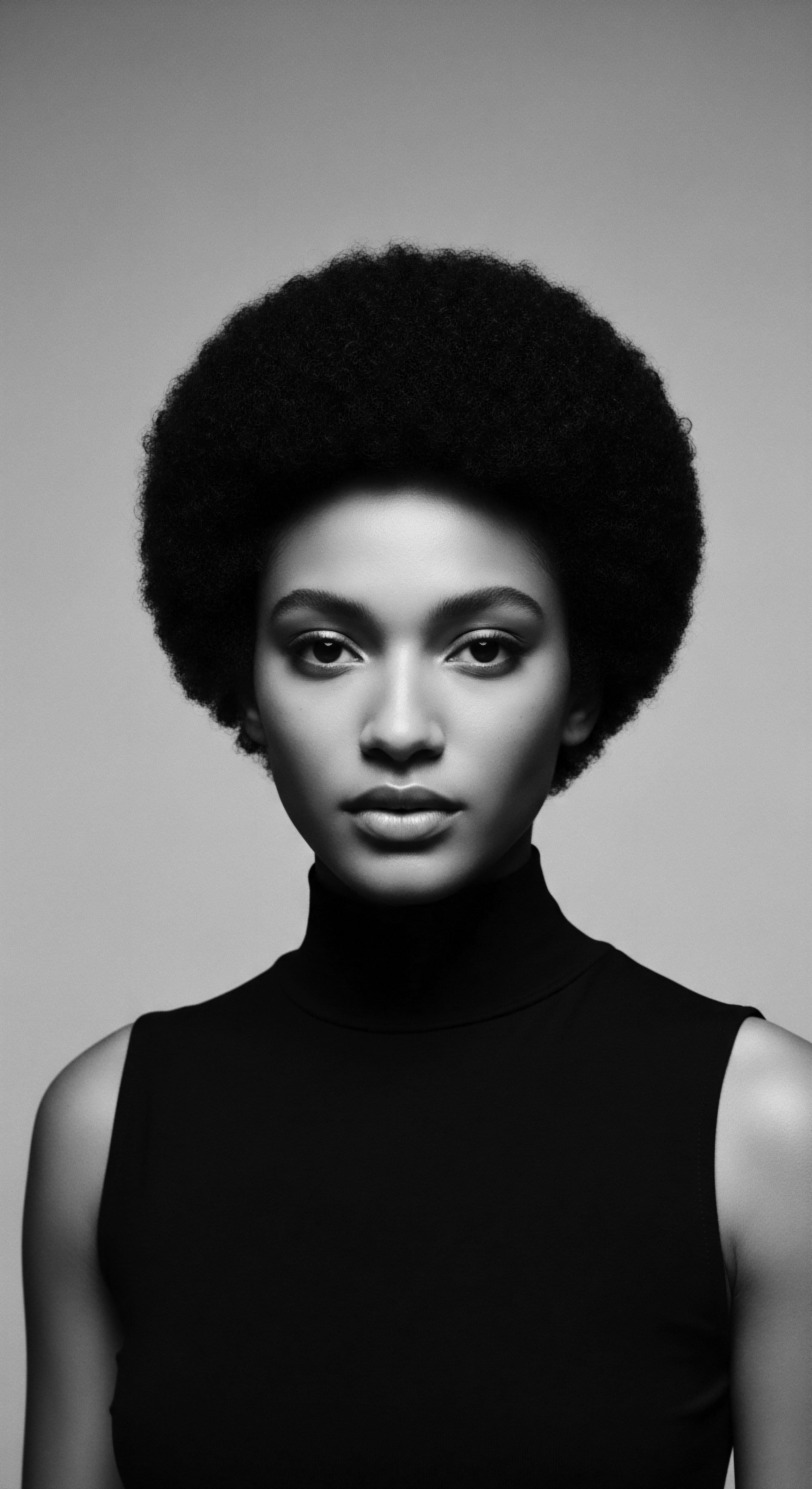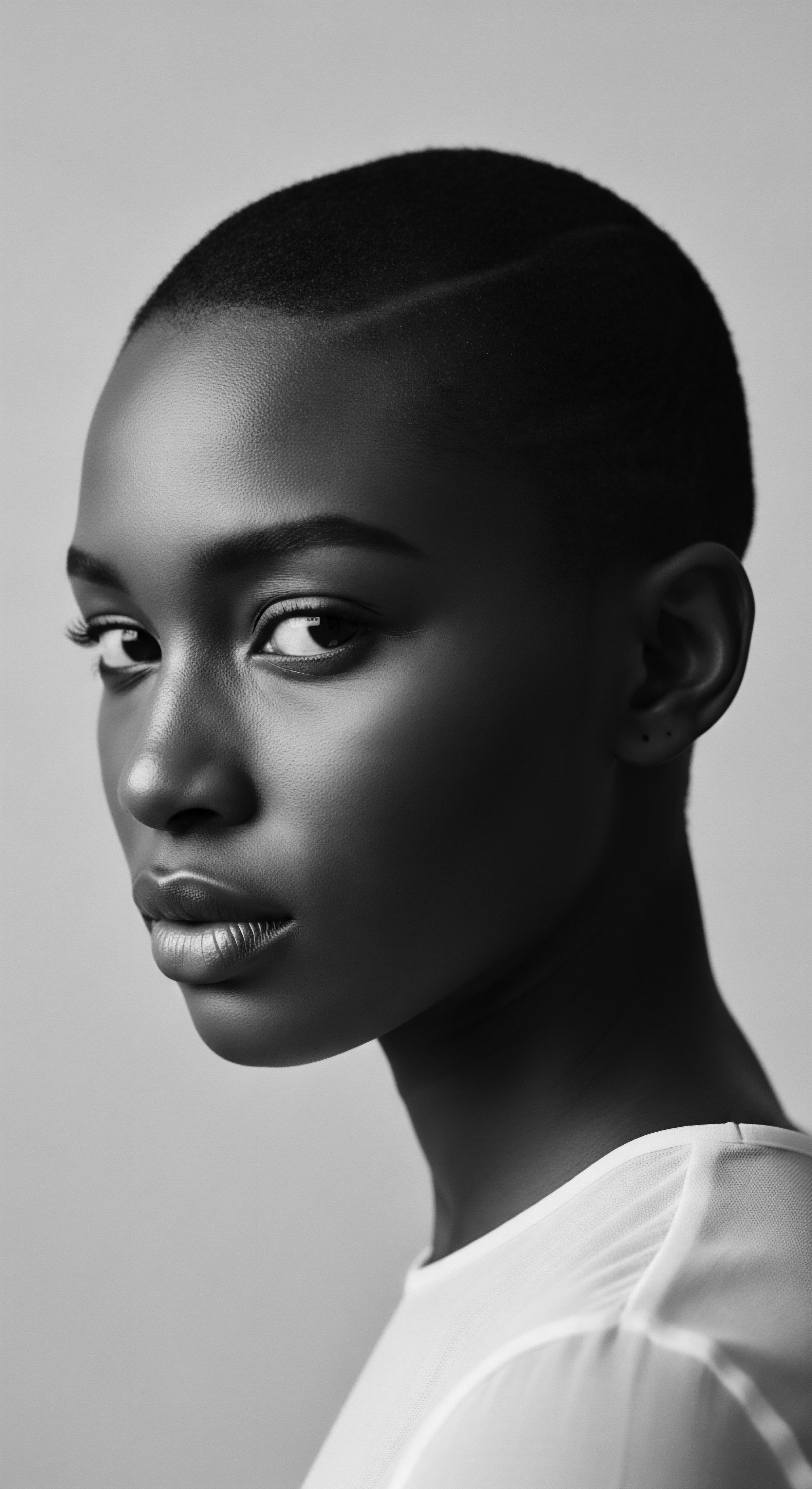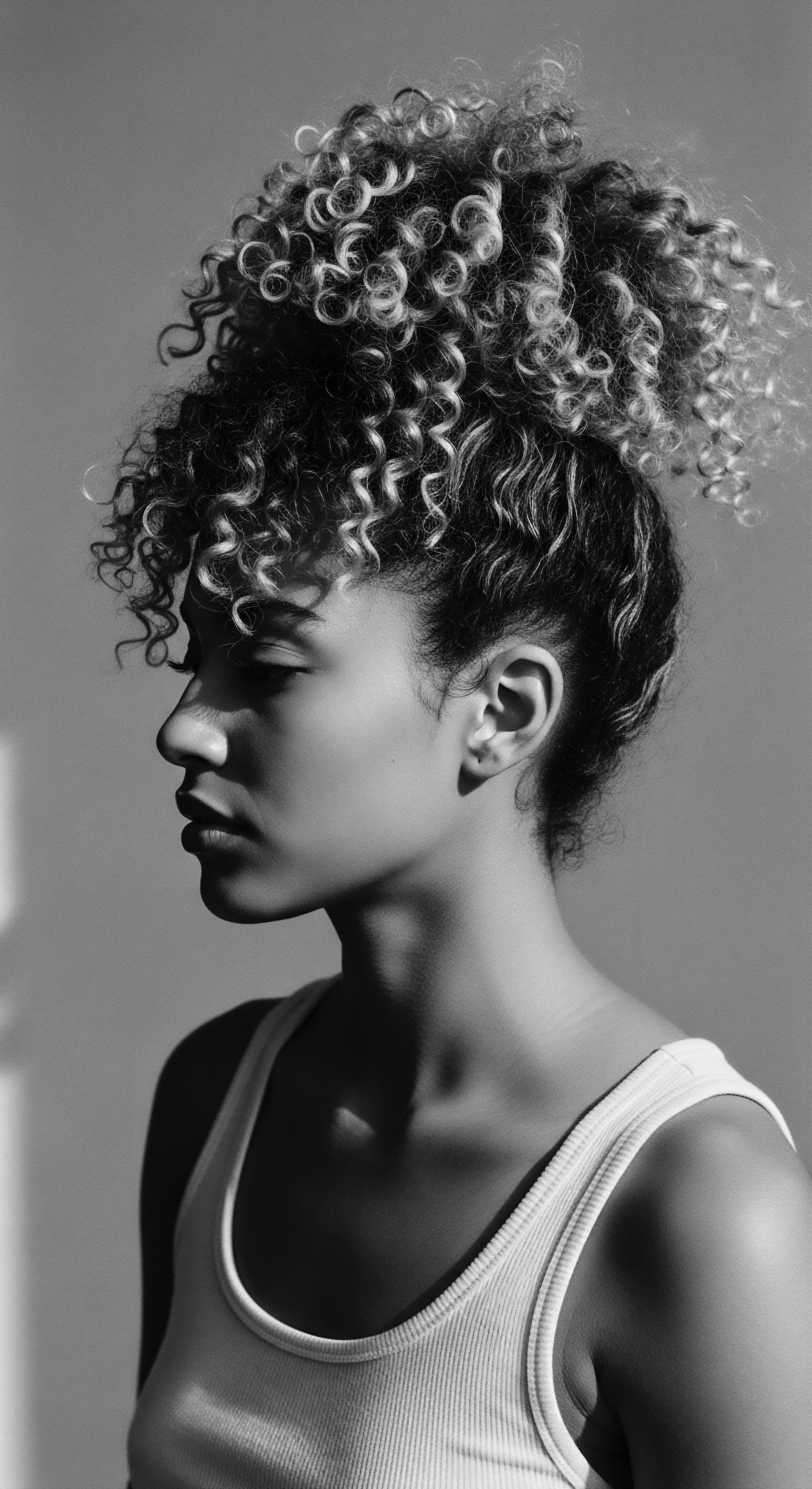
Roots
In the vibrant tapestry of human expression, hair stands as a profound marker of lineage, a living chronicle of ancestral journey. For those with textured hair, this connection runs especially deep, each curl and coil bearing the imprint of generations. It is a heritage expressed in intricate styles, in shared rituals passed down through familial hands, and in the very language used to describe its unique strength. Yet, within this rich history, a dissonant chord struck when early chemical relaxers arrived on the scene, promising a different aesthetic, but often at a devastating cost to the hair’s inherent spirit.

What Defines Textured Hair’s Natural Design?
The architecture of textured hair, whether a gentle wave or a tight coil, holds a singular elegance. Unlike straight hair, which typically presents a round cross-section, textured strands often possess an elliptical or flattened shape. This structural distinction shapes how hair grows, how it absorbs and retains moisture, and its natural tendency to form curls.
The cuticle, the hair’s protective outer layer, may be thinner or more unevenly distributed at the curves of a coil, making these points particularly vulnerable to external aggressors. Within the hair’s core, the cortex, intricate disulfide bonds hold the protein structure in place, giving each strand its inherent elasticity and form.
- Hair Follicle Shape ❉ Often elliptical or ribbon-like, dictating the curl pattern.
- Cuticle Integrity ❉ Potentially fewer, more lifted cuticle layers at turns, a point of fragility.
- Disulfide Bonds ❉ Numerous and strategically placed, forming the very essence of curl.
- Sebum Distribution ❉ Natural oils from the scalp struggle to travel down the length of coiled strands, leading to dryness.
Ancestral practices understood these delicate balances, employing natural oils, butters, and gentle cleansing methods to honor the hair’s design. These traditions, rooted in deep community wisdom, sought to sustain health rather than alter fundamental structure. They celebrated the hair’s volume, its spring, its defiant reach towards the sky.

How Did Early Chemical Approaches Clash with Hair’s Biology?
The advent of early chemical relaxers, primarily those formulated with lye (sodium hydroxide), introduced a profoundly different philosophy. These compounds operated on an extremely alkaline pH scale, often reaching values of 12 or higher. To put this in perspective, healthy hair and skin typically maintain a slightly acidic pH, somewhere between 4.5 and 5.5. This drastic shift in pH created an environment hostile to the hair’s natural equilibrium.
The aim was to permanently disrupt those very disulfide bonds responsible for the hair’s curl. The high alkalinity forced the hair shaft to swell dramatically, lifting the cuticle scales wide open, leaving the inner cortex exposed and vulnerable.
Early chemical relaxers, with their intensely alkaline nature, waged a war against the hair’s natural architecture, fundamentally altering its inherent resilience.
The process, known as lanthionization, involved a chemical reaction where a sulfur atom within the disulfide bond was removed, preventing the bond from reforming in its original coiled state. This reaction, while effective in achieving straightness, was also incredibly destructive. It could lead to a permanent weakening of the hair fiber, making it brittle, prone to breakage, and susceptible to environmental damage. Moreover, the scalp, a living extension of our being, was often subjected to severe chemical burns and irritation, a silent testament to the intensity of these early concoctions.
| Element Typical pH Range |
| Hair's Natural State 4.5 to 5.5 (Acidic) |
| Early Chemical Relaxer 12.0 to 14.0 (Highly Alkaline) |
| Element Cuticle Response |
| Hair's Natural State Lies flat, protects inner cortex |
| Early Chemical Relaxer Forced to swell and lift extensively |
| Element Disulfide Bonds |
| Hair's Natural State Maintain curl structure |
| Early Chemical Relaxer Permanently broken and reformed |
| Element The stark pH difference represents a fundamental chemical assault on the hair's biological integrity. |
These initial formulations lacked the conditioners and protective agents found in later, albeit still potent, versions. The focus was on straightening at nearly any cost, a reflection of the societal pressures that often overshadowed considerations of true hair health and ancestral practices of care. The damage was inherent not simply in application error, but in the very chemical philosophy at play.

Ritual
The journey of textured hair through history holds profound cultural weight. For generations, hair was a language, a symbol of identity, status, and spirit within diasporic communities. The arrival of early chemical relaxers, however, introduced a new, often painful, ritual into this ancient conversation.
It was a practice born from a complex interplay of societal pressures and a yearning for acceptance within dominant beauty frameworks. These relaxers became a tool, sometimes embraced, sometimes endured, in the quest for a perceived ideal that stood in stark contrast to the hair’s ancestral form.

What Social Forces Shaped Early Hair Choices?
In the aftermath of slavery and during periods of intense racial discrimination, a pervasive societal standard emerged, privileging straight hair as the epitome of beauty and professionalism. This was not a subtle suggestion; it was an unspoken mandate in workplaces, educational settings, and even within certain social circles. Textured hair, in its natural state, was often deemed “unruly,” “unprofessional,” or “unkept.” This cultural pressure created a deep-seated incentive for many Black and mixed-race individuals, especially women, to chemically alter their hair. It became a perceived pathway to social mobility, a means to navigate a world that often judged worth based on proximity to Eurocentric aesthetics.
Early beauty advertisements, often targeting Black women, perpetuated this ideology, equating straight hair with success, desirability, and an easier life. The choice to relax hair, therefore, was seldom a purely personal one. It was deeply intertwined with systemic oppression and the struggle for dignity and opportunity.
This shared experience, while varied in individual stories, threads through the collective memory of textured hair heritage. The act of relaxing, though damaging, sometimes provided a temporary shield against harsher societal judgments, a complex survival mechanism.

How Did Application Methods Add to Hair Damage?
The inherent harshness of early chemical relaxer formulas was compounded by the methods of their application. These products, often containing sodium hydroxide, were potent enough to cause chemical burns on the scalp if left on too long or applied without proper protection. Many individuals, seeking affordability, opted for at-home kits, often lacking the training or understanding of the delicate chemical process involved. The absence of precise instructions, the lack of proper tools, and the sheer strength of the chemicals frequently led to irreversible damage.
The widespread adoption of early chemical relaxers, fueled by societal pressures, often transformed hair care into a ritual of damage.
A common mistake involved applying the relaxer to previously treated hair, leading to “overlap” where already weakened strands were subjected to the corrosive chemicals again. This cumulative damage would thin the hair shaft, destroy its elasticity, and ultimately result in severe breakage. Scalp burns were not uncommon, sometimes leading to scarring alopecia, a permanent form of hair loss where the hair follicle is destroyed. These injuries were not merely cosmetic; they could be deeply painful, both physically and emotionally, underscoring the severe consequences of a beauty ideal that demanded chemical alteration.
| Method Hot Comb/Pressing |
| Approach to Hair Structure Temporarily alters hydrogen bonds with heat and oil. |
| Potential Damage (Early Eras) Heat damage, burns if applied improperly, oil residue. |
| Method Braiding/Twisting |
| Approach to Hair Structure Styles hair without chemical alteration. |
| Potential Damage (Early Eras) Tension alopecia if too tight, hair dehydration if not moisturized. |
| Method Early Chemical Relaxer |
| Approach to Hair Structure Permanently breaks disulfide bonds with high alkalinity. |
| Potential Damage (Early Eras) Severe chemical burns, irreversible fiber weakening, widespread breakage. |
| Method The shift to early chemical methods represented a radical departure from preserving the hair's natural integrity. |
The stories from this era often recount tales of burning scalps, weeping sores, and hair falling out in clumps. These personal narratives, passed down through families, stand as poignant reminders of the sacrifices made in pursuit of a particular look. The ritual of the relaxer, for many, became a painful testament to the pervasive influence of external beauty standards on the intimate landscape of personal identity and collective heritage.

Relay
The legacy of early chemical relaxers continues to echo through the landscape of textured hair care, a complex inheritance rooted in both scientific mechanics and societal pressures. Understanding the profound damage inflicted requires a deeper analytical lens, one that bridges the elemental chemistry of the past with the living heritage of communities who bore its consequences. This is not simply a historical footnote; it is a critical chapter in the unfolding story of Black and mixed-race hair, influencing contemporary perceptions and care practices.

How Did Understanding Hair’s Molecular Structure Reveal the Danger?
At its core, hair’s strength and elasticity derive from its protein structure, primarily keratin, reinforced by strong disulfide bonds between cysteine amino acids. These bonds act like sturdy rungs on a ladder, maintaining the hair’s coiled form. Early chemical relaxers, particularly those employing sodium hydroxide (lye), operated by initiating a process called lanthionization. This reaction permanently rearranged these crucial disulfide bonds.
The high pH of these formulas caused the hair’s outer cuticle layer to lift excessively, allowing the caustic chemicals to penetrate deeply into the cortex. Inside, the hydroxide ions cleaved the disulfide bonds, creating a new, weaker lanthionine bond in their place. This alteration stripped the hair of its natural curl memory and significantly compromised its structural integrity.
The result was hair that was permanently altered, often at the expense of its inherent health. This chemical assault led to what scientists now describe as irreversible protein degradation. The hair fiber became thinner, more porous, and devoid of the strength that allowed it to resist breakage.
Each subsequent application, targeting new growth, often overlapped with previously treated sections, creating layers of increasingly fragile hair. This layered damage compounded the problem, leading to chronic brittleness and hair loss.
A study on the health impacts of chemical hair straighteners, the National Institutes of Environmental Health Sciences’ Sister Study, highlighted the potential for significant adverse effects, including risks beyond direct hair damage, such as uterine cancer. This research underscores that the chemical exposure from relaxers could be more concerning due to increased absorption through the scalp, often made worse by burns or lesions caused by the straighteners (NIH, 2022).

What Were the Lasting Consequences of Early Relaxer Use?
The physical manifestations of damage from early chemical relaxers were manifold and severe. Beyond the immediate effects of chemical burns and scalp irritation, individuals experienced long-term consequences that profoundly impacted their hair health and often their emotional well-being. These included:
- Chronic Hair Breakage ❉ The weakened disulfide bonds and compromised protein structure meant hair snapped easily, leading to difficulty in retaining length.
- Scalp Trauma and Alopecia ❉ Repeated chemical burns could cause permanent scarring of the scalp (scarring alopecia), where hair follicles are irreversibly damaged, leading to bald patches. This was sometimes exacerbated by tension styles on already weakened hair.
- Extreme Dryness and Dullness ❉ The high alkalinity stripped the hair of its natural lipids and moisture, leaving it perpetually parched and lacking natural luster.
- Loss of Elasticity ❉ Healthy hair possesses a natural spring; chemically damaged hair lost this quality, becoming limp and lifeless.
These visible signs of distress were often accompanied by an emotional toll. The pursuit of a beauty ideal, while understandable in its historical context, inadvertently led to physical harm and a disconnect from one’s natural hair heritage. The journey from chemical relaxers to embracing natural hair textures has, for many, been a healing process, a reclamation of cultural and personal identity.
This shift is a testament to resilience, a turning away from harmful practices and towards ancestral wisdom that honors the hair’s intrinsic design. It is a reassertion of the soul within each strand, recognizing its connection to a deeper, more enduring legacy.
- Alkaline Application ❉ The strong alkaline solution opened the hair cuticle, allowing chemicals to penetrate.
- Disulfide Bond Cleavage ❉ Hydroxide ions broke the hair’s natural disulfide bonds.
- Structural Rearrangement ❉ Bonds were permanently altered to a straightened configuration.
- Neutralization (Often Insufficient) ❉ Incomplete neutralization left hair vulnerable to ongoing chemical activity.
- Post-Processing Trauma ❉ Hair was left fragile, prone to breakage and damage from styling.
The history of early chemical relaxers serves as a powerful reminder of how external pressures can influence intimate care practices. It highlights the scientific reality of chemical interactions with delicate biological structures and the enduring resilience of textured hair, which, despite challenges, continues to tell stories of strength, adaptation, and beauty rooted in a rich cultural past. The relay of this understanding from one generation to the next ensures that this history becomes a guide for future choices, prioritizing health and authenticity above all else.

Reflection
The story of early chemical relaxers and their impact on textured hair is a chronicle etched into the very fibers of a community’s heritage. It is a narrative woven with threads of aspiration, societal expectation, and the often-unseen costs of conformity. As we look back, we perceive not simply a scientific failure or a cosmetic trend, but a complex interplay of forces that shaped identities, dictated choices, and left indelible marks, both visible and unseen, on millions of individuals.
The spirit of a strand, as we often consider, holds more than just biological data; it stores memory, resistance, and the quiet dignity of a lineage. The damage inflicted by those harsh, early chemicals was not merely physical. It represented a severing, however temporary, from the innate glory of a natural curl, a departure from practices steeped in centuries of ancestral wisdom. Yet, the enduring power of textured hair’s heritage is its capacity for regeneration, for returning to its authentic form, and for reclaiming its place as a symbol of strength and beauty.
In understanding this past, we honor the choices made by previous generations, recognizing the context in which they existed. We also gain clarity to make different choices today, guided by a deeper scientific appreciation for hair’s biology and a profound reverence for its cultural significance. The journey of textured hair is a continuous conversation between past wisdom and present understanding. It reminds us that true care extends beyond the surface, touching the very soul of a strand, and celebrating the boundless beauty of its unbound helix.

References
- National Institutes of Health. (2022). Frequent use of hair straightening products tied to higher uterine cancer risk.
- Collins, P. H. (2000). Black Feminist Thought ❉ Knowledge, Consciousness, and the Politics of Empowerment. Routledge.
- Mercer, K. (1994). Welcome to the Jungle ❉ New Positions in Black Cultural Studies. Routledge.
- Byrd, A. D. & Tharps, L. D. (2014). Hair Story ❉ Untangling the Roots of Black Hair in America. St. Martin’s Press.
- Khumalo, N. P. et al. (2007). Relaxers damage hair ❉ Evidence from amino acid analysis. Journal of the American Academy of Dermatology, 57(1), 163-165.
- Roberts, A. (2016). Natural Hair in the Military ❉ Regulation and Resistance. Feminist Studies, 42(3), 666-688.
- Shetty, V. H. (2013). Chemical hair relaxers have adverse effects ❉ A myth or reality. International Journal of Trichology, 5(1), 26–28.
- Weitz, J. (2004). A History of the Hairdresser. Andre Deutsch Ltd.
- Tress, L. M. (1999). Hair in African Art and Culture. The Museum for African Art.
- Wilkerson, M. (1983). The Science of Black Hair. Cornrows & Co.
